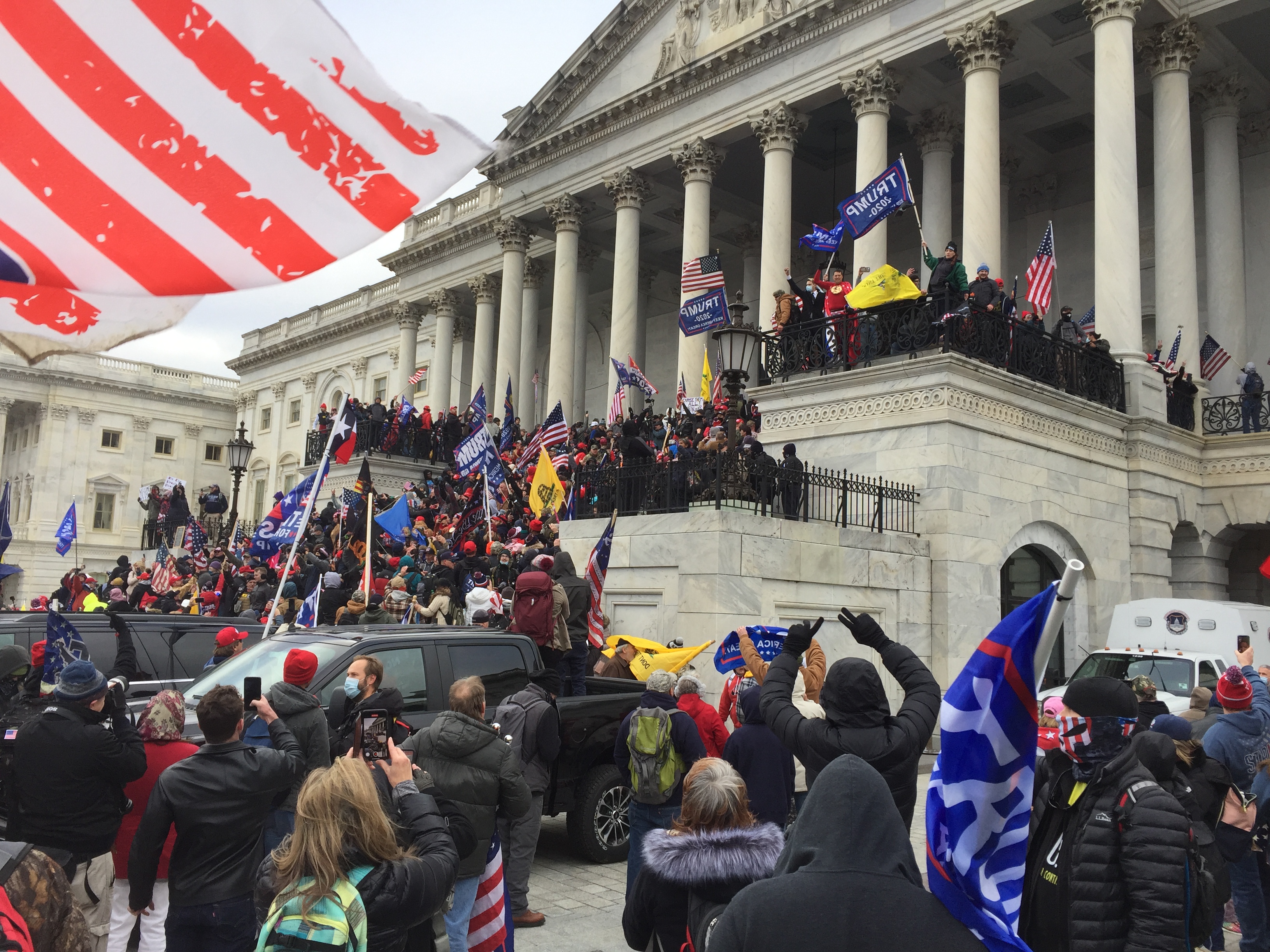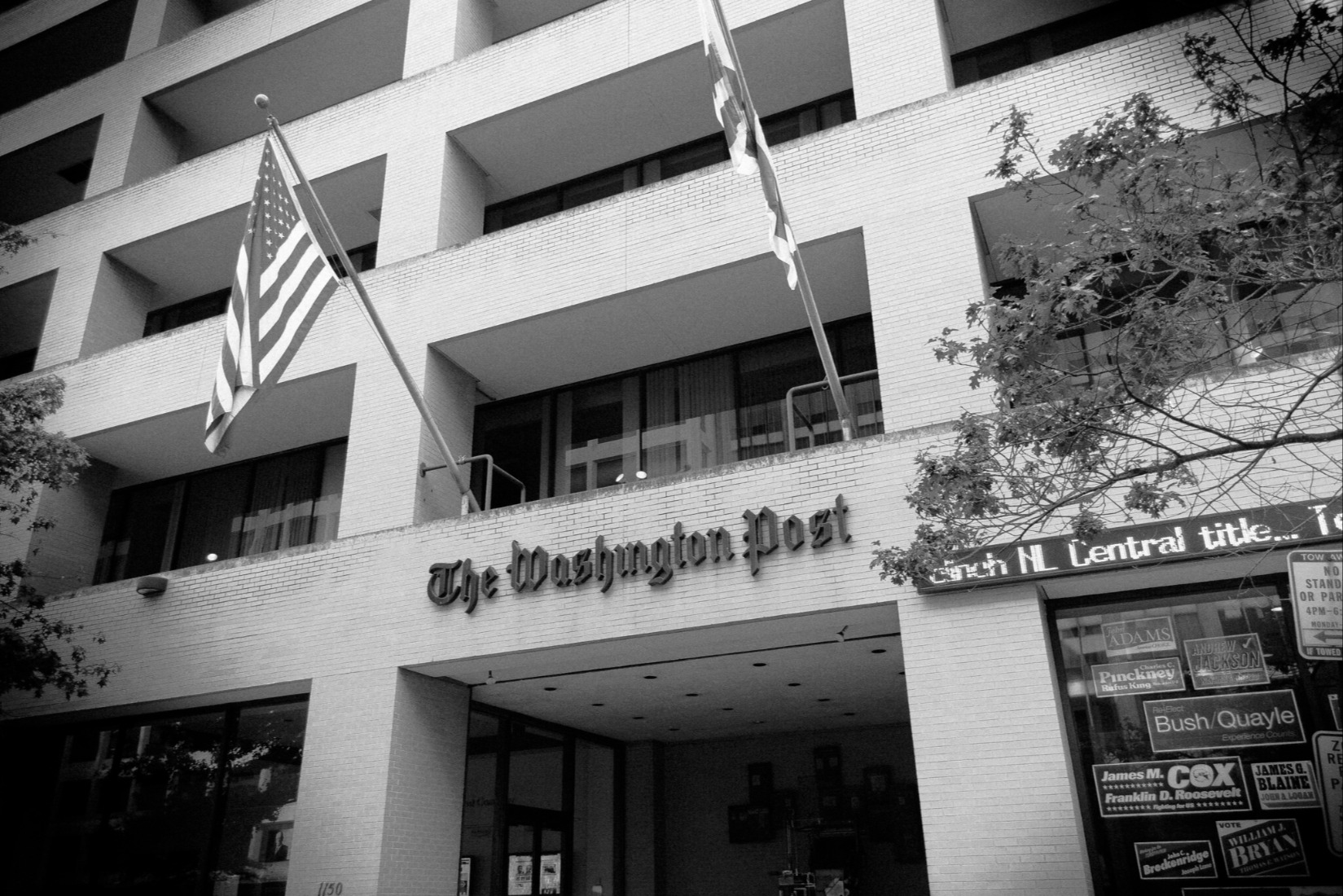The D.C. Circuit Holds the Power to Upend Hundreds of Prosecutions of Jan. 6 Rioters
After a U.S. district court judge dismissed the most important felony charge against Jan. 6 Capitol insurrectionists, the D.C. Circuit hears oral arguments. A dispatch from the D.C. Circuit.

Published by The Lawfare Institute
in Cooperation With

It’s the morning of Dec. 12, and Courtroom 31 in the U.S. Court of Appeals for the District of Columbia Circuit is sparsely populated—a surprise given that the court is about to hear an appeal with the power to topple hundreds of prosecutions of Jan. 6 rioters. Most attendees seem to be law clerks, seated in a separate gallery. A handful of reporters are staggered across the aisle in the “Press” area. Seated two rows in front of me, in the “Reserved for Legal Team and Guests” zone, are two of the three defendants—Garrett Miller and Joseph Fischer—and their wives.
The case before the court today is perhaps the most important Jan. 6 case to be heard by the D.C. Circuit, not least of all because it could upend the government’s ability to deploy its stiffest penalty against Jan. 6 insurrectionists—the charge of corruptly obstructing an official proceeding under 18 U.S.C. § 1512(c)(2), which carries a 20-year sentence.
The full text of the relevant statute reads as follows:
(c) Whoever corruptly—
(1) alters, destroys, mutilates, or conceals a record, document, or other object, or attempts to do so, with intent to impair the object’s integrity or availability for use in an official proceeding; or
(2) otherwise obstructs, influences, or impedes any official proceeding, or attempts to do so,
shall be fined under this title or imprisoned not more than 20 years, or both.
Prosecutors leveled this charge against Miller (who hails from Texas) and Fischer (a police officer from Pennsylvania), as well as Edward Jacob Lang (who hails from the Hudson Valley but was not present at court that day), for storming the Capitol on Jan. 6, 2021, to halt or delay the joint session of Congress and its certification of the Electoral College’s votes.
In cases like Miller’s, Fischer’s, and Jacob’s, the D.C. District Court—and district courts across the U.S.—have upheld the obstruction charge, moving the case along to trial to determine whether sufficient evidence is available to convict the rioters. At least 70 Jan. 6 rioters have already been convicted under § 1512(c)(2), and many have been convicted of that offense alone,including, as Lawfare Senior Editor Roger Parloffnotes, Jacob Chansley (better known as the “QAnon Shaman”), Olympic swimmer Klete Keller, four members of the paramilitary Oath Keepers organization, and four members of the Proud Boys. In all, more than 290 of the more than 910 individualswho’ve been charged with federal crimes stemming from Jan. 6 have been charged under § 1512(c)(2) and await trial. So, in the government’s arsenal of legal charges, § 1512(c)(2) is the most important one.
That’s why earlier this year, when U.S. District Judge Carl J. Nichols dismissed each of the obstruction felony charges leveled against Miller, Fischer, and Lang, prosecutors became nervous. Was this ruling just a blip, or the beginning of the end of the government’s ability to bring § 1512(c)(2) charges against the Jan. 6 insurrectionists?
Parloff has written extensively about Nichols’s reasoning and the arguments on both sides, hereand here, as well as how other judges have interpreted § 1512(c)(2) and upheld the charge in other Jan. 6 cases, here. I won’t belabor the point. A summation of what Nichols has concluded is this: 1512(c)(2) is a catch-all provision, as evidenced by the word “otherwise” at the beginning of the subsection. The best way to give meaning to the word “otherwise” would be to read it in context with 1512(c)(1), which states that whoever corruptly “alters, destroys, mutilates, or conceals a record, document, or other object” can be found guilty. In other words, a defendant can be charged under 1512(c)(2) for obstruction of an official proceeding as long as the defendant has taken some action with respect to a “document, record, or some other object”—like, for instance, “cover[ing] up, falsif[ying], or mak[ing] a false entry in a record,” not for rioting or participating in an insurrection. The defendants’ actions, though abhorrent, did not fall under Nichols’s narrow interpretation of § 1512(c)(2).
Against this backdrop, Judges Gregory Katsas, Justin Walker, and Florence Pan pose the first question to the government: Why doesn’t 1512(c)(2) indicate offenses similar to the ones listed in (c)(1)?
The Department of Justice prosecutor, James Pearce, starts with the text. The more “natural meaning of ‘otherwise,’ [the one found] in various dictionaries, is ‘another way’ or ‘a different way’, not a different-but-fundamentally-similar-way.”
But what about “slap, punch, kick or otherwise hurt? [Here,] hurt does not mean economic harm,” asks Katsas. How would that be interpreted?
Pearce concedes that when there is a long list of “things,” at the end of which ‘and otherwise’ punctuates the sentence, the court may appropriately apply canons of interpretation, including ejusdem generis(general words must not be interpreted in a way that renders specific words previously used in the provision meaningless)and noscitur a sociis(statutory words derive meaning from the company they keep). But as a matter of structure and purpose, and as noted by U.S. District Judge Randolph Mossin the Jan. 6 case where he upheld the obstruction charge, § 1512(c)(2)’s prohibition is separate and distinct. Subsection (c)(2)’s prohibition has verbs and objects that are distinct from the prohibition in the earlier subsection (c)(1).
Pearce also reminds the panel that defendants are not asking the court to uphold Nichols’s interpretation of the statute, but to reinterpret subsection (c)(2) to read “impairment of evidence” into the text, rather than “documents, records, or some other objects.” Herein lies the core problem when 1512(c)(2) is interpreted beyond the plain meaning of the text: “You’re going down a path where you’re going to end up with no one really knowing what this means. If you stick to the plain text of the prohibition, you don’t take that path.”
Katsas flashes a coy smile. “Each reading … has its difficulties, but I’m not sure clarity cuts in your favor.” Pan quickly leans into her mic and attempts to salvage Pearce’s argument: “Is there any textual basis for impairing evidence?” Pearce says there is none.
The entire exchange up until now seems predictable, pleasant even. But then things get testy. Walker opens the first can of worms that morning when he asks: “What is your definition of corrupt?”
Pearce’s response is quick but cautious. He ventures to define corruptly as “acting with independently corrupt or unlawful means or corrupt purpose.”
Walker further homes into the language. “How do you define ‘independently corrupt’ then?”
Pearce says the real question is whether the meanswere “independently unlawful.”
“Were they? Were all the means alleged against the defendants in the indictment independently unlawful?” asks Walker.
Pearce says they were. See “the trespass, the assault, the civil disorder …. [These were the] means by which defendants carried out their obstruction of the congressional proceeding.”
“What about ‘independently corrupt purpose’?”
Pearce notes “independently corrupt purpose” is sufficient but not necessary to prove “corruptly.” It’s best defined as an “intent to bring about something unlawful, influencing someone to violate a legal duty, or intent to gain some improper or unlawful benefit.”
“What’s your support for that?” Walker asks.
Pearce says it’s the late D.C. Circuit Judge Laurence Silberman’sconcurrence in U.S. v. North.
And that’s when the rubber hits the road. “Why should we pick Judge Silberman’s [definition]? If you’re going to pick a judge, he’s certainly a great one to pick—” The gallery chuckles. A shadow of a grin breaks across Walker’s face, but he remains steadfast in his questioning. “Why should we pick [Silberman’s] definition as opposed to a dozen other contenders?” Pearce says it’s because Silberman’s definition recognizes that people can lawfully obstruct Congress, his definition focuses on independently corrupt means, and his concurrence places limitations on their conduct. Then Pan enters the chat to remind the court that “corruptly” is not at issue before the panel. Several heads in the gallery nod in agreement. When did “corruptly” become the issue? We’d signed up to hear more about “otherwise.”
But this buildup is not all for naught. Walker asks the prosecutor one final question that hints at what the panel may decide in this case. “In a moment right now when you don’t know if we’re going to rule for you on the ‘corruptly’ question or with the defense, would you rather us answer that [‘corruptly’] question now if we rule for you on the other questions first, or would you rather us rule on the other questions first and then remand to judge Nichols to decide the ‘corruptly’ question? ”
Pearce takes a brief pause. “Probably not decide [the ‘corruptly’ question] now.”
Pearce ends his argument responding to three conventional statutory interpretation questions: the issue of surplusage, “elephants in mouseholes” doctrine, and the title of the statute.
Pearce concedes that the government’s interpretation may produce more surplusages—in other words, render some words in the statute unnecessary—than the competing interpretation by the defense. Still, “[o]verlap in criminal law is not unusual, and not a reason to give an artificial limiting construction when you’ve got plain language as you do here.”
How about the elephants in the mouseholes problem? Pearce says there is none. Section 1512(c)(2) sits at the end of the most serious provision, “exactly where a reader would expect a catch-all provision to sit.”
And yes, while the preexisting title of § 1512 reads, “Tampering with a witness, victim or informant” and the relevant Title 11 in the Sarbanes-Oxley Act reads, “Corporate Fraud Accountability,” the provision that became 1512(c)(2) was titled “Tampering with a record or otherwise impeding an official proceeding,” which supports the government’s interpretation that 1512(c)(1) and (c)(2) are two distinct prohibitions.
Pearce is done. He steps back. The defense attorney, Nicholas Smith, saunters to the podium. The atmosphere is prickly, and it’s about to get pricklier.
Smith is barely audible. Pan interrupts him and asks him to speak into the mic. When he does, he dives head first into “The offense in Section 1532(c)(2) is an evidence impairment crime. It’s been an evidence impairment crime since Sarbanes-Oxley was enacted in 2002[.]” Pan fires off the first question, “What is the textual basis for [the evidence impairment]?” It’s sharp. Unflinching. Her posture has also changed. She’s seated taller in her chair. Smith’s answer is that we must read the statute in context, not parse out the dictionary definition of each word. This leads Pan to pose a second question, then a third, then a fourth.
Pan, who hardly asked two questions to the government lawyer, sets the tenor for the second half of the oral argument. With each subsequent question, her frustration mounts, thanks to counsel’s inability to stop talking when she interjects and also because of counsel’s insistence on offering a different legal theory (that is, an impairment of evidence theory) than the one decided on by Nichols. Still, Pan doesn’t cease.
“Are you defending Judge Nichols’s holding?”
“Of course, andwe’re taking it a step further—”
“No, no, I’m, just asking you, do you think Judge Nichols ruled correctly and are you defending his —”
“Absolutelyhe ruled correctly—”
“Then whyare you offering a different theory?”
Smith insists he’s not offering a different theory from the one offered by Nichols, and then proceeds to offer a different interpretation of Nichols’s theory. The judge and counsel go back and forth on the issue several times before Pan is visibly exasperated and ready to move on. Except Smith doesn’t let her. When she interjects, he continues speaking. She tries again. Nope, he’s still not ready. I catch the clerks seated to my right exchange glances at one another. I suspect they feel the same way I do. If our first-year law school oral argument class taught us anything, it’s that you shut up when the judge starts talking. And so, Pan enlightens him. “Excuse me counsel, when I start speaking, you need to stop.” Smith is flustered and impulsively responds, “Thank you.” He’s ready to move on now.
But things don’t stop there. They go from prickly, to reasonable, to confusing, to perplexing in the 45 minutes of dizzying back-and-forth.
First, the reasonable. Smith reopens the can of worms on the “corruptly” issue. He articulates the due process concern that seems to captivate Katsas and Walker’s attention. He argues that although the government maintains that the focus of “corruptly” should be on “unlawful means,” “wrongful purpose,” however, “has been included in every or virtually every jury instruction as sufficient” to prove a “corrupt” mens rea. So where’s the rub? According to Smith, “people try to interfere with congressional proceedings all of the time. In that context, any wrongful purpose is unconstitutionally vague.” Pan, for her part, once again questions whether “corruptly” is before the court and insinuates that the panel would either need supplemental briefing to decide the issue or remand back to Nichols. Smith resurrects the issue of “corruptly” many times thereafter, and Pan voices her impatience, even rolling her eyes at times.
Now, the confusing. Pan wants to know if obstructing the examination of ballot certificates—the documents the congressional joint session was examining on Jan. 6—falls within Nichols’s definition of § 1512(c)(2) as encompassing “documents, records, or other objects,” and “evidence impairment” writ large. Smith says no. To even get to the question of evidence, a congressional investigation or inquiry must be initiated, he says.
Pan reaches her wits end: “Counsel, forgive me, but I just find it a little frustrating because I feel like it’s whack a mole. I try to hone in on one aspect of the statute and then you answer me about a different aspect of the statute.” Smith chuckles nervously, promises “no more moles, Your Honor,” and proposes the contested presidential election in 2000 as an example to support his larger point that ballots do not constitute evidence. The lawyers and operatives working for one of the campaigns who flew down to Florida to stop the counting of the votes with hanging chads could, in retrospect, be defined as obstructing an official proceeding if ballot counting were to qualify as documentary evidence. That would, Smith suggests, be absurd.
“If this sounds like a fanciful hypothetical—” Smith begins.
“Yes it does,” Pan quips and then leans back, baffled, in her chair.
And the perplexing comes immediately after, when Smith suggests that the government’s interpretation of § 1512(c)(2) will lead to injustice because of the disparity between a misdemeanor offense for parading and protesting and a felony offense under 1512(c)(2). The former carries a six-month maximum sentence, while the latter carries a hefty 20-year maximum sentence. Walker, who has been uncharacteristically quiet throughout Smith’s argument, expresses “umbrage” at the notion that “injustice” and “gross imbalancing of equities” would result.
“Counsel, one of your clients said, ‘It was war. Period. This was no protest. Period.’ Right?”
“Absolutely.”
“So, we’re not talking about a protest, right?”
“We would push back on the notion that one person determines what protest is without looking at the objective facts.” Smith responds.
Walker is unsatisfied. “Was this a protest or was this something more?”
“When you take it as a whole, absolutelynot. Running into the Capitol, assaulting police officers, conspiring to stop the vote count, those are all notacts of protests.”
But Walker is not convinced. “[T]he teams of lawyers who went down to Florida that you analogized to Jan 6 rioters today, they didn’t say ‘civil war should start,’” he says, reading straight from the record. “They didn’t use a grappling hook or rope, with a level three vest and helmet and a mouthguard and a bump cap, like one of your clients did. They didn’t say ‘a democratic congress should be taken to the gallows,’ like one of your clients did. They didn’t say ‘we should have a mob trial.’ They didn’t punch, kick, punch officers.” Walker pauses. Fischer is emotionless. The folks seated in front of me exchange glances. They’re beaming. Katsas and Pan keep their gaze fixed on counsel, and I wonder if they feel moved by what can best be described as Walker’s soliloquy.
“I think you would have to concede that this has nothing to do with the protestor outside the Capitol with a sign, or with a lawyer who goes down to Florida to try to enforce Florida law and federal law to ensure a fair election,” Walker concludes. “The attack on the Capitol—wasn’t that unprecedented?” Smith agrees it was.
Pearce’s rebuttal is uneventful, and some in the gallery tiptoe to the exit after Smith finds his seat. Overall, the government attorney has enjoyed much smoother sailing than defense counsel. Nichols’s interpretation of § 1512 was always somewhat idiosyncratic among district judges—of the many trial judges in D.C. who have presided over Jan. 6 prosecutions, he’s the only one to throw out a 1512 charge on this reasoning—and based on oral arguments, the D.C. Circuit panel seems fairly skeptical of his read of the statute.
Especially, it seems, Judge Pan. When the case is submitted, I pass the defense team on my way out and overhear them bemoaning Pan’s line of questioning, aware that the judge seems unlikely to rule in their favor. “Well,” someone says matter-of-factly, “we know where she’s coming from.”





